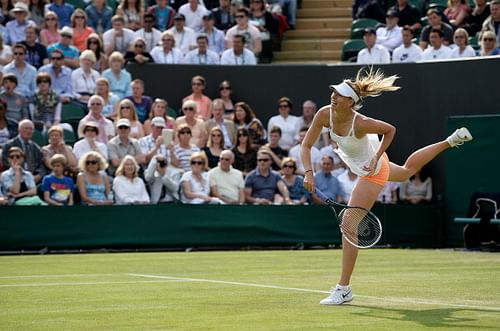
Players seek solutions to Wimbledon court crisis

Maria Sharapova pleaded with Wimbledon to allow players to practice on their cherished show courts in an effort to solve the injury crisis that has plagued the tournament.
The Russian third seed and 2004 champion suffered a painful second round exit at the hands of Portuguese qualifier, Michelle Larcher De Brito, the world 131, on the unfamiliar surroundings of Court Two on Wednesday.
Sharapova slipped three times, complained the surface was dangerous and needed an medical time-out to treat the left hip she injured in her falls.
She believes that players should be allowed to practice on the show courts at Wimbledon before the tournament gets underway to help them familiarise themselves with the conditions.
“Especially those courts, even Centre Court, Court 1, 2, 3, maybe having the opportunity to practice on them a few days before, because no one can practice on them,” said Sharapova.
“The first few days, you just know that they’re going to just be really different.”
De Brito believes that Court Two was treacherous on Wednesday.
Earlier, former world number one Caroline Wozniacki fell and needed her ankle bandaged on her way to defeat to Petra Cetkovska.
“I saw how she fell pretty hard and I know these grass courts can be really slippery and can be quite dangerous,” said Larcher De Brito, who took victory on a fifth match point.
“There’s a lot of grass that’s been cut that didn’t get swept off so there’s a lot of dead grass on the top and it made it quite slippery.”
On Wednesday there were seven injury pullouts either through retirements or withdrawals, a record for one day at a Grand Slam.
World number two and Australian Open champion Victoria Azarenka withdrew just minutes before she was due on Centre Court to face Italian veteran Flavia Pennetta for a place in the third round with a knee injury.
That injury was picked up when she fell on Court One on Monday in her opening win.
French sixth seed Jo-Wilfried Tsonga quit his match with Latvia’s Ernests Gulbis with a knee injury at the end of the third set.
Steve Darcis, the conqueror of Rafael Nadal, withdrew with a shoulder injury also suffered through a fall on Court One on Monday.
Croatian 10th seed Marin Cilic and Kazakhstan’s Yaroslava Shvedova withdrew while John Isner and Radek Stepanek quit during their second round matches.
“It would be great if the club or somebody who takes care of the court would examine or try to find an issue so that wouldn’t happen,” said second seeded Azarenka.
There have already been calls for the men’s matches to be reduced to best-of-three sets at the Grand Slams, instead of five in an effort to reduce the danger of injuries.
Some in the sport also want to see Wimbledon, the Australian and French Opens follow the example of the US Open and introduce a fifth-set tie-breaker.
But Cilic insists the five-set format should remain.
“Playing in the Grand Slam has to be something special. It is not decided by one hour of great tennis that you have on that day, which can happen two out of three, best out of three set matches,” he said.
“Grand Slams have been like that for many, many years. I wouldn’t like to see it go best of three sets. Everybody would want to see the winner who really deserve to win it.”
Gulbis, too, believes the integrity of the current system should be protected and prefers the five-set system.
“I wouldn’t like it, because this is the difference between the top players,” said the Latvian.
“You have to be physically fit. Grand Slam is a Grand Slam. You don’t need easy way to win it.
“If you can’t make it, you can’t make it. Sorry. Stay at home and do something else. Grand Slam should be five sets, blood, fight five sets all the way until the end, until somebody is dead.”